Bamberg
This articleneeds additional citations forverification.(May 2023) |
Bamberg
Bambärch(Mainfränkisch) | |
|---|---|
Top: Skyline with old town hall (Altes Rathaus) to the right Middle:Michaelsberg AbbeyBottom:Bamberg Cathedral | |
| Coordinates:49°53′29″N10°53′13″E/ 49.89139°N 10.88694°E | |
| Country | Germany |
| State | Bavaria |
| Admin. region | Upper Franconia |
| District | Urban district |
| Government | |
| •Lord mayor(2020–26) | Andreas Starke[1](SPD) |
| Area | |
| • Total | 54.62 km2(21.09 sq mi) |
| Elevation | 262 m (860 ft) |
| Population (2023-12-31)[2] | |
| • Total | 80,580 |
| • Density | 1,500/km2(3,800/sq mi) |
| Time zone | UTC+01:00(CET) |
| • Summer (DST) | UTC+02:00(CEST) |
| Postal codes | 96047, 96049, 96050, 96051, 96052 |
| Dialling codes | 0951 |
| Vehicle registration | BA |
| Website | www |
| Official name | Town of Bamberg |
| Criteria | Cultural: ii, iv |
| Reference | 624 |
| Inscription | 1993 (17thSession) |
| Area | 142 ha |
| Buffer zone | 444 ha |
Bamberg(/ˈbæmbɜːrɡ/,[3]USalso/ˈbɑːmbɛərk/,[4][5]German:[ˈbambɛʁk];East Franconian:Bambärch) is a town inUpper Franconiadistrict inBavaria,Germany, on the riverRegnitzclose to its confluence with the riverMain.Bamberg had 79,000 inhabitants in 2022.[6]The town dates back to the 9th century, when its name was derived from the nearbyBabenberchcastle. Cited as one of Germany's most beautiful towns, with medieval streets and buildings, the old town of Bamberg with around 2,400timberhouses[7]has been aUNESCO World Heritage Sitesince 1993.[8]
From the 10th century onwards, Bamberg became a key link with the Slav peoples, notably those of Poland and Pomerania. It experienced a period of great prosperity from the 12th century onwards, during which time it was briefly the centre of theHoly Roman Empire.EmperorHenry IIwas buried in the old town, alongside his wifeKunigunde.The town's architecture from this period strongly influenced that inNorthern GermanyandHungary.From the middle of the 13th century onwards, the bishops were princes of the Empire[9]and ruled Bamberg, overseeing the construction of monumental buildings. This growth was complemented by the obtaining of large portions of the estates of theCounts of Meranin 1248 and 1260 by the sea, partly through purchase and partly through the appropriation of extinguished fiefs.
Bamberg lost its independence in 1802, following the secularization of church lands, becoming part ofBavariain 1803. The town was first connected to the German rail system in 1844, which has been an important part of its infrastructure ever since. After a communist uprising took control over Bavaria in the years followingWorld War I,the state government fled to Bamberg and stayed there for almost two years before the Bavarian capital ofMunichwas retaken byFreikorpsunits (seeBavarian Soviet Republic). The first republican constitution of Bavaria was passed in Bamberg, becoming known as theBamberger Verfassung(Bamberg Constitution).
Following theSecond World War,Bamberg was an important base for the Bavarian, German, and then American military stationed atWarner Barracks,until closing in 2014.
History
[edit]
Prince-Bishopric of Bamberg1245–1802
Electorate of Bavaria1802–1805
Kingdom of Bavaria1805–1918
German Empire1871–1918
Weimar Republic1918–1933
Nazi Germany1933–1945
Allied-occupied Germany1945–1949
West Germany1949–1990
Germany1990–present

During the post-Romancenturies of Germanic migration and settlement, the region later included in theDiocese of Bambergwas inhabited for the most part bySlavs.The town, first mentioned in 902, grew up by the castleBabenberchwhich gave its name to theBabenbergfamily. On their extinction, it passed to theSaxonhouse.[9]The area was Christianized chiefly by the monks of theBenedictineFulda Abbey,and the land was under the spiritual authority of theDiocese of Würzburg.In 1007,Holy Roman EmperorHenry IImade Bamberg a family inheritance, the seat of a separatediocese.The Emperor's purpose in this was to make the Diocese of Würzburg less unwieldy in size and to give Christianity a firmer footing in the districts ofFranconia,east of Bamberg.[citation needed]
In 1008, after long negotiations with the Bishops of Würzburg andEichstätt,who were to cede portions of their dioceses, the boundaries of the new diocese were defined, andPope John XVIIIgranted the papal confirmation in the same year. Henry II ordered the building of a newcathedral,which was consecrated on 6 May 1012. The church was enriched with gifts from the pope, and Henry had it dedicated in honor of him. In 1017, Henry foundedMichaelsberg Abbeyon the Michaelsberg ( "Mount St Michael" ), near Bamberg, a Benedictine abbey for the training of the clergy.[citation needed]The emperor and his wife,Kunigunde,gave large temporal possessions to the new diocese, and it received many privileges out of which grew the secular power of the bishop. Pope Benedict VIII visited Bamberg in 1020[10]to meet Henry II for discussions concerning the Holy Roman Empire. While he was there he placed the diocese in direct dependence on theHoly See.He also personally consecrated some of Bamberg's churches. For a short time Bamberg was the centre of theHoly Roman Empire.Henry and Kunigunde were both buried in the cathedral.[citation needed]

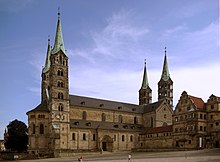
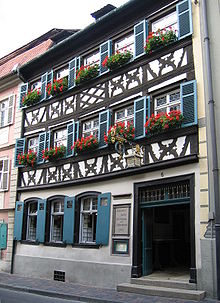
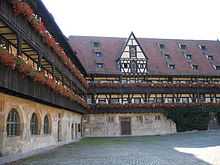
From the middle of the 13th century onwards, the bishops were princes of the Empire[9]and ruled Bamberg, overseeing the construction of monumental buildings. In 1248 and 1260, the see obtained large portions of the estates of theCounts of Meran,partly through purchase and partly through the appropriation of extinguished fiefs.[citation needed]
The oldBishopric of Bambergwas composed of an unbroken territory extending fromSchlüsselfeldin a northeasterly direction to theFranconian Forest,and possessed in addition estates in the Duchies ofCarinthiaandSalzburg,in theNordgau(the presentUpper Palatinate), inThuringia,and on theDanube.By the changes resulting from theReformation,the territory of this see was reduced by nearly one half in extent. Since 1279 thecoat of arms of the city of Bambergis known in the form of a seal.[citation needed]
Thewitch trialsof the 17th century claimed about one thousand victims in Bamberg, reaching a climax between 1626 and 1631, under the rule ofPrince-BishopJohann Georg II Fuchs von Dornheim.[11]The famousDrudenhaus(witch prison), built in 1627, is no longer standing today; however, detailed accounts of some cases, such as that ofJohannes Junius,remain.[12]
In 1647, theUniversity of Bambergwas founded asAcademia Bambergensis.[13]
Bambrzy(Posen Bambergers) are GermanPoleswho are descended from settlers from the Bamberg area who settled in villages aroundPoznańin the years 1719–1753. In 1759, the possessions and jurisdictions of the diocese situated inAustriawere sold to that state. When the secularization of church lands took place (1802) the diocese covered 3,305 km2(1,276 sq mi) and had a population of 207,000. Bamberg thus lost its independence in 1802, becoming part ofBavariain 1803.[14]The free state of Bavaria and the Federal Republic of Germany gave protections to Bamberg, though the city does handle its own management of properties.[15]
Bamberg was first connected to the German rail system in 1844, which has been an important part of its infrastructure ever since. After a communist uprising took control over Bavaria in the years followingWorld War I,the state government fled to Bamberg and stayed there for almost two years before the Bavarian capital ofMunichwas retaken byFreikorpsunits (seeBavarian Soviet Republic). The first republican constitution of Bavaria was passed in Bamberg, becoming known as theBamberger Verfassung(Bamberg Constitution).[16]
In February 1926 Bamberg served as the venue for theBamberg Conference,convened byAdolf Hitlerin his attempt to foster unity and to stifle dissent within the then-youngNazi party.Bamberg was chosen for its location in Upper Franconia, reasonably close to the residences of the members of the dissident northern Nazi faction but still within Bavaria.[17]
Historical population
[edit]| Year | Population |
|---|---|
| 1818 | 17,000 |
| 1885 | 31,521 |
| 1905 | 45,308 |
| Largest groups of foreign residents | |
| Nationality | Population (2013) |
| 1,076 | |
| 359 | |
| 232 | |
| 119 | |
| 115 | |
Geography
[edit]Bamberg is located inFranconia,63 km (39 mi) north ofNurembergby railway and 101 km (63 mi) east ofWürzburg,also by rail. It is situated on the Regnitz river, 3 km (1.9 mi) before it flows into theMainriver.
Its geography is shaped by theRegnitzand by the foothills of theSteigerwald,part of the German uplands. From northeast to southwest, the town is divided into first the Regnitz plain, then one large and several small islands formed by two arms of the Regnitz (Inselstadt), and finally the part of town on the hills, the "Hill Town" (Bergstadt).
The seven hills of Bamberg
[edit]Bamberg extends over seven hills, each crowned by a church. This has led to Bamberg being called the "Franconian Rome" — although a running joke among Bamberg's tour guides is to refer to Rome instead as the "Italian Bamberg". The hills are Cathedral Hill, Michaelsberg, Kaulberg/Obere Pfarre, Stefansberg, Jakobsberg, Altenburger Hill and Abtsberg.[18]
Climate
[edit]Climate in this area has mild differences between highs and lows, and there is adequate rainfall year-round.[citation needed]TheKöppen climate classificationsubtype for this climate is "Cfb"(Marine West Coast Climate/Oceanic climate), with a certain continental influence as indicated by average winter nighttime temperatures well below zero.[19]
| Climate data for Bamberg (1991−2020 normals) | |||||||||||||
|---|---|---|---|---|---|---|---|---|---|---|---|---|---|
| Month | Jan | Feb | Mar | Apr | May | Jun | Jul | Aug | Sep | Oct | Nov | Dec | Year |
| Record high °C (°F) | 15.8 (60.4) |
19.9 (67.8) |
24.4 (75.9) |
31.8 (89.2) |
33.3 (91.9) |
35.5 (95.9) |
37.9 (100.2) |
38.3 (100.9) |
33.3 (91.9) |
27.6 (81.7) |
21.9 (71.4) |
16.0 (60.8) |
38.3 (100.9) |
| Mean maximum °C (°F) | 11.1 (52.0) |
13.3 (55.9) |
19.1 (66.4) |
24.9 (76.8) |
28.7 (83.7) |
32.3 (90.1) |
33.3 (91.9) |
33.1 (91.6) |
27.7 (81.9) |
22.4 (72.3) |
15.9 (60.6) |
11.6 (52.9) |
35.0 (95.0) |
| Mean daily maximum °C (°F) | 3.7 (38.7) |
5.5 (41.9) |
10.3 (50.5) |
15.9 (60.6) |
20.0 (68.0) |
23.4 (74.1) |
25.5 (77.9) |
25.3 (77.5) |
20.2 (68.4) |
14.4 (57.9) |
7.9 (46.2) |
4.3 (39.7) |
14.7 (58.5) |
| Daily mean °C (°F) | 0.7 (33.3) |
1.3 (34.3) |
5.0 (41.0) |
9.5 (49.1) |
13.9 (57.0) |
17.3 (63.1) |
19.1 (66.4) |
18.5 (65.3) |
13.9 (57.0) |
9.3 (48.7) |
4.6 (40.3) |
1.6 (34.9) |
9.6 (49.3) |
| Mean daily minimum °C (°F) | −2.6 (27.3) |
−2.6 (27.3) |
−0.1 (31.8) |
2.8 (37.0) |
7.1 (44.8) |
10.8 (51.4) |
12.5 (54.5) |
12.0 (53.6) |
8.2 (46.8) |
4.7 (40.5) |
1.3 (34.3) |
−1.3 (29.7) |
4.4 (39.9) |
| Mean minimum °C (°F) | −12.6 (9.3) |
−10.8 (12.6) |
−7.0 (19.4) |
−4.0 (24.8) |
0.5 (32.9) |
4.9 (40.8) |
7.1 (44.8) |
6.0 (42.8) |
2.1 (35.8) |
−2.5 (27.5) |
−5.8 (21.6) |
−11.2 (11.8) |
−15.7 (3.7) |
| Record low °C (°F) | −29.7 (−21.5) |
−25.7 (−14.3) |
−19.6 (−3.3) |
−9.7 (14.5) |
−4.1 (24.6) |
−1.0 (30.2) |
1.4 (34.5) |
0.7 (33.3) |
−2.5 (27.5) |
−7.5 (18.5) |
−18.0 (−0.4) |
−27.3 (−17.1) |
−29.7 (−21.5) |
| Averageprecipitationmm (inches) | 46.8 (1.84) |
37.2 (1.46) |
43.2 (1.70) |
35.0 (1.38) |
60.7 (2.39) |
61.5 (2.42) |
78.8 (3.10) |
59.9 (2.36) |
55.5 (2.19) |
49.5 (1.95) |
51.9 (2.04) |
54.5 (2.15) |
634.6 (24.98) |
| Average precipitation days(≥ 0.1 mm) | 16.0 | 14.0 | 14.4 | 12.2 | 13.1 | 13.5 | 14.9 | 12.3 | 12.4 | 15.4 | 15.4 | 17.4 | 171.1 |
| Average snowy days(≥ 1.0 cm) | 8.1 | 6.3 | 2.1 | 0.1 | 0 | 0 | 0 | 0 | 0 | 0 | 1.3 | 4.2 | 26.0 |
| Averagerelative humidity(%) | 84.5 | 81.2 | 75.7 | 69.5 | 70.6 | 71.1 | 71.3 | 73.6 | 79.8 | 84.9 | 88.0 | 87.3 | 78.4 |
| Mean monthlysunshine hours | 52.0 | 79.4 | 124.2 | 181.2 | 209.4 | 220.6 | 230.4 | 218.9 | 159.3 | 102.9 | 48.8 | 39.4 | 1,666.6 |
| Source 1:NOAA[20] | |||||||||||||
| Source 2: Infoclimat[21] | |||||||||||||
Economy
[edit]Bamberg is considered an important economic center and is one of the 15 strongest economic regions in Bavaria compared to the other 95 districts and independent cities. Central locations for industry, manufacturing and trade can be found in the north and east of the city. In the north, around the Bamberg harbor, there is a large industrial area that partly extends into the Hallstadt urban area. Bosch operates its largest plant in Germany in the east and is also the city's most important employer.
Relevant economic sectors in Bamberg are the automotive supply industry, electrical engineering and the food industry. The traditional industry of market gardening with large inner-city cultivation areas, which has characterized the city since its beginnings, is still present. Due to its UNESCO World Heritage status and the more than 800,000 overnight guests a year in the city alone, tourism, hotels and gastronomy also play a central role in the city's economy.[22]
Key economic figures
[edit]In the 2010s, Bamberg's gross domestic product increased by a total of 17.7%. The city of Bamberg generated €5.1 billion in 2021 (€66,543 per capita).
| 2010 | 2011 | 2012 | 2013 | 2014 | 2015 | 2016 | 2017 | 2018 | 2019 | 2020 | 2021 |
|---|---|---|---|---|---|---|---|---|---|---|---|
| 52.403 | 54.083 | 53.694 | 56.029 | 56.320 | 58.070 | 60.349 | 62.917 | 64.083 | 64.040 | 63.650 | 66.543 |
In the 2016 Future Atlas, Bamberg was ranked 32nd out of 402 districts, municipal associations and independent cities in Germany, making it one of the places with "very high future prospects".
The number of business registrations in the city of Bamberg remains at a high level. In the independent city of Bamberg, the number of business registrations in 2023 was 682, compared to 655 registrations the year before. In 2021, 702 new companies were registered with the city of Bamberg. The number of businesses in the city of Bamberg for 2023 is 2,624 companies. 87 of these businesses employ more than 100 people. Of these, almost half (969) are craft businesses.[24]
Labour market and employment figures
[edit]As the population in the city has grown, the number of employees has also risen continuously in recent years:[23]Between 2005 and 2022, the number of employees increased by almost 20%.[24]
| 2015 | 2016 | 2017 | 2018 | 2019 | 2020 | 2021 | 2022 | |
|---|---|---|---|---|---|---|---|---|
| Employees subject to social security contributions | 52.259 | 53.181 | 54.078 | 54.695 | 54.478 | 57.435 | 55.414 | 56.491 |
| Number of unemployed people | 1.894 | 1.839 | 1.765 | 1.628 | 1.579 | 1.922 | 1.931 | 1.814 |
There are around 56,500 people in employment in the city in 2022. The unemployment rate in December 2022 was 4.3%, above the Bavarian average of 3.1%. In the neighboring district of Bamberg, the unemployment rate was 2.3%.[25]
Industry and manufacturing
[edit]Important sectors of the manufacturing industry in Bamberg are drive technologies and electrical engineering. Bosch has been operating a production facility in Bamberg with over 6000 employees since 1939. The company produces energy, mobility and drive systems, in particular spark plugs for the automotive industry. Due to its dependence on the combustion engine, the company announced in 2019 that it would be switching to fuel cells,[145] although around 1000 jobs are to be transferred to other locations from 2026. Coburg-based automotive supplier Brose has had an administration building with 600 employees on Berliner Ring since 2016. Together with the plant in Hallstadt, the region is the company's second-largest location with more than 2,000 employees.[26]
Another important company is Wieland Electric in the field of electrical engineering. The company was founded in Bamberg in 1910 and is considered a pioneer in electrical connection technology and is still the world market leader for pluggable installation technology in the building sector.
Rudolf Zimmermann Bamberg (RZB), with over 800 employees worldwide, produces lights and lighting systems near the port of Bamberg.[27]Over 70 companies are located on the 100 hectares of the port. In 2023, over 416,000 tons of goods were loaded at the port, especially foodstuffs and bulk goods. In addition, over 700 river cruise ships docked here.[28]The Bamberg asphalt mixing plant[29]and a Schwenk concrete plant are also located in the immediate vicinity.
Bamberg is also home to numerous small and medium-sized companies in other sectors. One special feature here is the centuries-old tradition of instrument making. Organ building, which is currently being continued by master craftsman Thomas Eichfelder, is particularly noteworthy, as is the construction of violins, clarinets and other woodwind instruments.
Tourism and retail
[edit]Bamberg's city centre is characterized by a diverse retail sector, partly due to tourism. This generated a turnover of 682 million euros in 2023. In the 2018 shopping mile ranking by real estate company Jones Lang LaSalle (JLL), Bamberg was ranked first in Germany for cities with fewer than 100,000 inhabitants. With an average of 5,155 visitors per hour, the Grüner Markt was the 52nd most popular shopping street in Germany. In 2023, the Grüner Markt had almost 8.5 million passers-by, an increase of 130,000 visitors compared to the previous year.[30]
Bamberg recorded 807,294 overnight stays in 2023, an increase of 11% compared to 2022. 85% of overnight guests came from Germany, 15% from abroad. The proportion of travelers from abroad rose particularly sharply in 2023 at 22%. The most important tourist countries of origin are the US, the Netherlands, Poland and Austria. Tourism generates around 330 million euros in gross revenue in Bamberg every year - in the hospitality, retail and service sectors. This results in an income of 153 million euros.[24]
Attractions
[edit]
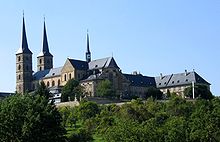

The Town of Bamberg was inscribed on theUNESCOWorld Heritage List in 1993 due to its medieval layout and its well preserved historic buildings.[8]Since the Middle Ages, urban gardening has been practiced in Bamberg. The Market Gardeners’ District together with the City on the Hills and the Island District is an integral part of the World Heritage site. In 2005, the Municipality established a unit to coordinate the implementation of the World Heritage Convention in Bamberg. In 2019, a visitor and interpretation centre opened for the World Heritage site.[31]
Some of the main sights are:
- Bamberg Cathedral(1237), with the tombs of Emperor Henry II andPope Clement II
- Alte Hofhaltung,residence of the bishops in the 16th and 17th centuries
- Neue Residenz,residence of the bishops after the 17th century
- Bamberg State Libraryin the New Residence
- Old town hall(1386), built in the middle of the Regnitz river, accessible by two bridges
- Klein-Venedig( "Little Venice" ), a colony of fishermen's houses from the 19th century along one bank of the river Regnitz
- Michaelsberg Abbey,built in the 12th century on one of Bamberg's "Seven Hills." The former Benedictine abbey, which once housed a brewery, is now home to the Franconian Brewery Museum.[32]
- Altenburg,castle, former residence of the bishops
- Cathedral
Bamberg Cathedralis a lateRomanesquebuilding with four towers. It was founded in 1004 by Emperor Henry II, finished in 1012[9]and consecrated on 6 May 1012. It was later partially destroyed by fire in 1081. The new cathedral, built by SaintOtto of Bamberg,was consecrated in 1111[33]and in the 13th century received its present late-Romanesque form.[citation needed]
The cathedral is 94 m (308 ft) long, 28 m (92 ft) wide, 26 m (85 ft) high, and the four towers are each about 81 m (266 ft) high. It contains many historic works of art, such as the marble tomb of the founder and his wife, considered one of the greatest works of the sculptorTilman Riemenschneider,and carved between 1499 and 1513.[citation needed]Another treasure of the cathedral is anequestrian statueknown as theBamberg Horseman(Der Bamberger Reiter).[9]This statue, possibly depicting the emperorConrad III,most likely dates to the second quarter of the 13th century. The statue also serves as a symbol of the town of Bamberg.[citation needed]
- Neue Residenz
TheNeue Residenz(New Residence) (1698–1704) was initially occupied by the prince-bishops, and from 1864 to 1867 by the deposed KingOtto of Greece.ItsRosengarten(Rose Garden) overlooks the town. It has over 4500 roses.[34]
- Altenburg
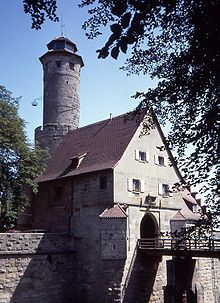
TheAltenburgis located on the highest of Bamberg's seven hills. It was mentioned for the first time in 1109.[35]Between 1251 and 1553 it was the residence of Bamberg's bishops. Destroyed in 1553 byAlbert Alcibiades, Margrave of Brandenburg-Kulmbach,it was used after scant repairs only as a prison, and increasingly fell into decay.
In 1801, A. F. Marcus bought the castle and completely repaired it. His friend, the famous German writerE.T.A. Hoffmann,who was very impressed by the building, lived there for a while. The next owner, Anton von Greifenstein, in 1818 founded an association to preserve the castle. This society still maintains the entire property today.[citation needed]The Altenburg today houses a restaurant.[36]
- Other sights
Other churches are theJakobskirche,an 11th-century Romanesquebasilica;theSt. Martinskirche;theMarienkircheorObere Pfarrkirche(1320–1387), which has now been restored to its original pureGothicstyle. TheMichaelskirche,12th century Romanesque (restored), on the Michaelsberg, was formerly the church of theBenedictineMichaelsberg Abbeysecularized in 1803 and now contains theBürgerspital,oralmshouse,and the museum and municipal art collections.[citation needed]
Of the bridges connecting the sections of the lower town theObere Brückewas completed in 1455. Halfway across this, on an island, is theRathausor town hall (rebuilt 1744–1756). The lyceum, formerly aJesuitcollege, contains a natural history museum. The old palace (Alte Hofhaltung) was built in 1591 on the site of an old residence of the counts ofBabenberg.Monuments include the Maximilian fountain (1880), with statues ofKing Maximilian I of Bavaria,the emperor Henry II and his wife,Conrad IIIandSaint Otto,bishop of Bamberg.[9]
There are also tunnels beneath the town. These were originally constructed as mines which supplied sandstone which could be used for construction or as an abrasive cleaner. Mining came to an end in 1920 but a 7.5 mi (12.1 km) tunnel network remained. The tunnels were used as anair raid shelterduring World War II. A part of the network can be visited on a guided tour.[37]
Beer
[edit]Bamberg is known for its smokedRauchbierand is home to 11 breweries,[38]includingBrauerei Fässla,Brauerei Greifenklau,Brauerei Heller-Trum (Schlenkerla),Brauerei Kaiserdom,Keesmann Bräu,Klosterbräu,Mahrs Bräu,Brauerei Spezial,Gasthausbrauerei Ambräusianum, Kron Prinz, and Weyermann Röstmalzbierbrauerei. Weyermann Specialty Malting, founded in Bamberg in 1879, supplies breweries around the world. Every August there is a five-daySandkerwa,akirmesscelebrated with beers.[39]The Franconia region surrounding Bamberg is home to more than 200 breweries. In October and early November many of the 70 breweries in and around Bamberg celebrate Bockbieranstiche with special releases of Bock beer.[40]
Education
[edit]TheUniversity of Bamberg,named Otto-Friedrich University, offers higher education in the areas ofsocial science,business studiesand thehumanities,and is attended by more than 12,000 students.[41]The University of Applied Sciences Bamberg offers higher education in the areas ofpublic health.Bamberg is also home to eight secondary schools (gymnasiums):
- Clavius-Gymnasium
- Dientzenhofer-Gymnasium
- Eichendorff-Gymnasium
- E.T.A. Hoffmann-Gymnasium
- Franz-Ludwig-Gymnasium
- Kaiser-Heinrich-Gymnasium
- Maria-Ward-Gymnasium
- Theresianum
There are also numerous other institutes for primary, secondary, technical, vocational and adult education.
Infrastructure
[edit]Transport
[edit]Railway
[edit]TheInterCityExpressmain line No. 28 (Munich–Nuremberg–Leipzig–Berlin/ –Hamburg) and the main line No. 18 (Munich – Nuremberg – Halle – Berlin / – Hamburg) run on theNuremberg–Bambergand theBamberg–Hof linesthrough theBamberg station.It takes less than two hours to Munich on the train and with theNuremberg–Erfurt high-speed railwaythrough the Thuringian mountains finished in 2017 less than three hours to Berlin. Two intercity trains of line no. 17 (Vienna – Warnemünde) and line no. 61 (Leipzig – Nuremberg – Karlsruhe) also run through Bamberg.[citation needed]
East-west connections are poorer. Bamberg is connected to other towns in eastern Upper Franconia such asBayreuth,Coburg,andKronachvia theBamberg–Hof linewith trains usually running at least every hour. Connections on theWürzburg–Bamberg lineto the west are hourly regional trains to Würzburg, which is fully connected to the ICE network. Tourists arriving atFrankfurt International Airportcan take advantage of the new direct connection from Frankfurt's main station.[citation needed]
Motorways
[edit]Bamberg is not near any of the major (i.e. single-digit)autobahns.But it is nevertheless well connected to the network in all directions: theA70fromSchweinfurt(connecting to theA7there) to Bayreuth (connecting to theA9) runs along the northern edge of the town. TheA73on the eastern side of town connects Bamberg to Nuremberg (connecting to theA9) andThuringia,ending atSuhl.[citation needed]
Air transport
[edit]Bamberg is served byBamberg-Breitenau Airfield.Mostly public aircraft operate there. It used to be a military airport. (IATA-Code: ZCD, ICAO-Code: EDQA) It is also possible to charter public flights to and from this airport.[citation needed]
Most international tourists who travel by plane arrive atFrankfurt International AirportorMunich Airport.The nearest major airport isNuremberg Airportwhich can be reached within 45mins by car or one hour by train and subway.[citation needed]
Water transport
[edit]
Both theRhine-Main-Danube Canaland its predecessor, theLudwig Canal,begin near Bamberg.[42]The Ludwig Canal was opened in 1846 but closed in 1950 after damage during thesecond world war.With the completion of the Rhine-Main-Danube Canal in 1992, uninterrupted water transport was again made possible between theNorth Seaand theBlack Sea.
Local public transport
[edit]Local public transport within Bamberg relies exclusively on buses. More than 20 routes connect the outlying quarters and some villages in the vicinity to the central bus station. In addition, there are several "Night Lines" (the last of these, though, tend to run around midnight) and somepark-and-ridelines from parking lots on the periphery to the town centre.
A short-lived tram system existed in the 1920s.
Military bases
[edit]Bamberg was an important base for the Bavarian, German, and then American military stationed atWarner Barracks.[43]Warner Barracks was closed in the fall of 2014, with the last battalion leaving being the 54th Engineer Battalion, and the grounds returned to the German government. In 2016, a large part of the facility was taken over by theGerman Federal Policefor training purposes. Muna Kasserne was a small base occupied by the 504th Maintenance Company, 71st Maintenance Bn. It was part of Warner Barracks although located separately.[citation needed]
Governance
[edit]Bamberg is an urban district, orkreisfreie Stadt.Its town council (Stadtrat) and its mayor (Oberbürgermeister) are elected every six years, though not in the same year. Thus, the last municipal election for the town council was in 2014, for the mayor in 2012. As an exception to the six-year term, the term starting in 2012 will take eight years to synchronize the elections with those in the rest of Bavaria.[citation needed]
As of the elections of 16 March 2014, the 44 member strong town council comprises 12CSUcouncillors, 10SPDcouncillors, 8Greencouncillors, 4 councillors of theBamberger Bürger-Blockand 4 of theFreie Wähler(Free Voters), both local political movements. These five parties achieved the number of councillors necessary to form aparliamentary group.In addition, there are 3 councillors of theBamberger Unabhängige Bürgerand the 1 councillor each of theBamberger Realisten,theFDPand theBamberger Linke Liste.[citation needed]
The previous council, elected on 2 March 2008, was composed of 15CSUcouncillors, 10SPDcouncillors, 7Greencouncillors, 5 councillors of the Bamberger Bürger-Block and 3 of the Freie Wähler (Free Voters), both local political movements. These five parties achieved the number of councillors necessary to form aparliamentary group.In addition, there were 2 councillors of theBamberger Realistenand one of theFDPand theRepublikaner,making them ineligible for caucus status.[citation needed]
Mayors since 1945
[edit]| Years | Mayor | Party |
|---|---|---|
| 1945–1958 | Luitpold Weegmann | CSU |
| 1958–1982 | Theodor Mathieu | CSU |
| 1982–1994 | Paul Röhner | CSU |
| 1994–2006 | Herbert Lauer | Independent |
| 2006–present | Andreas Starke | SPD |
Twin towns – sister cities
[edit]Notable people
[edit]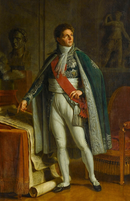
A-K
[edit]- Annette von Aretin(1920–2006), first television announcer of theBayerischer Rundfunk
- Carl Adam Bader(1789 in Bamberg; † 1870 in Berlin),tenor
- Lisa Badum
- Dorothee Bär(born 1978), Member of Parliament (CSU), State Secretary of the Federal Minister of Transport and Digital Infrastructure
- Wilhelm Batz(1916–1988),Luftwaffe,ace
- Louis-Alexandre Berthier(1753–1815), Chief of Staff to Napoleon Bonaparte
- Theodor Boveri(1862–1915), biologist and cytogeneticist
- Joachim Camerarius(1500–1574), humanist, polymath and poet
- Claudia Ciesla(born 1987), Polish-German actress
- Pope Clement II(died 1047), bishop of Bamberg from 1040 to 1046
- Christopher Clavius(1538–1612), mathematician, astronomer and Jesuit
- Conrad III of Germany(1093–1152), king of Germany
- Cunigunde of Luxembourg(c. 975–1040), empress consort, regent of the Holy Roman Empire and wife of Henry II
- Stefan Dassler(born 1962), non-fiction author
- Günther Denzler(born 1948), former district administrator of Bamberg (CSU)
- Karlheinz Deschner(1924–2014), writer and critic of religion and the church
- Gottfried Diener(1907–1987), philologist and Goethe researcher
- Ignaz Dollinger(1770–1841), physician
- Ignaz von Dollinger(1799–1890), important Catholic theologian and church historian
- Curt Echtermeyer,also known as Curt Bruckner (1896–1971), painter
- Erich Ebermayer(1900–1970), writer
- Hans Ehard(1887–1980), lawyer and politician
- Günter Faltin(born 1944), university teacher
- Heinrich Finck(1444–1527), conductor and composer
- Klaus-Dieter Fritsche(born 1953), jurist and politician (CSU),
- Karl von Gareis(1844–1923), a lawyer and author, member of the Reichstag
- Nora-Eugenie Gomringer(born 1980), poet and writer
- Thomas Gottschalk(born 1950), moderator, TV presenter, actor
- Lukas Görtler(born 1994), football player
- Hans Grassmann(born 1960), physicist and author
- Joseph Heller(1798–1849), collector, today Helleriana in Bamberg State Library
- Karl Höller(1907–1987), composer
- Georg Wilhelm Friedrich Hegel(1770–1831), German philosopher
- Henry II(973–1024), Holy Roman Emperor
- E. T. A. Hoffmann(1776–1822), German author and composer
- Joachim Jung(born 1951), artist
- Harry Koch(born 1969), football player
- Lorenz Krapp(1882–1947), lawyer, poet and politician (BVP, CSU)
- Dieter Kunzelmann(born 1939), communard and left-wing activist
- Paul Lautensack(1478–1558), painter and organist
L-Z
[edit]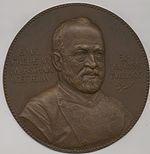
- Paul Maar(born 1937), German writer and illustrator
- Emil Marschalk von Ostheim(1841–1903), historian and collector
- Duke Maximilian Joseph in Bavaria(1808–1888), promoter of Bavarian folk music in the 19th century
- Willy Messerschmitt(1898–1978), German aircraft designer,Flugzeugbau Messerschmitt GmbH
- Wolf-Dieter Montag(1924–2018), German physician, sports medicine specialist, mountain rescue doctor, and international sports administrator
- Christina Morhaubt,convicted of witchcraft and sentenced to death by burning in 1627 during theBamberg witch trials
- Martin Münz(1785–1848), anatomist and professor
- Ida Noddack-Tacke, (1896–1978), chemist and physicist; she discovered element 75,rhenium
- Christopher Park(born 1987), pianist
- Bernd Redmann(born 1965), composer and musicologist
- Mike Rose(1932–2006), painter, set designer and writer
- Gerd Schaller(born 1965), conductor
- Rainer Schaller(born 1969), entrepreneur and founder ofMcFitFitness GmbH
- Claus Schenk Graf von Stauffenberg(1907–1944), German officer who attempted to assassinate German dictatorAdolf Hitlerin the20 July Plot
- Berthold Maria Schenk Graf von Stauffenberg(born 1934), former General of the Bundeswehr
- Franz-Ludwig Schenk Graf von Stauffenberg(born 1938), former Bavarian European parliament member
- Ritter Josef von Schmitt(1838–1907), German noble, CourtPresidentfor theKingdom of Bavaria,advisor toPrince Luitpold of Bavaria,Privy councilorand anHonorary Citizenof the city of Bamberg.
- Gottfried von Schmitt(1827–1908), German noble, member ofSupreme courtand member of Upper Council ofBavaria.
- Josef Schmitt(1875–1944), German noble andPrivy councillor.
- Gottfried Schmitt(1865–1919), German politician
- Josh Shipp(born 1986), professional basketball player forBrose BasketsBamberg
- Tom Schütz(born 1988), football player
- Sven Schultze(born 1978), basketball player
- Karsten Tadda(born 1988), basketball player
- Karl Borromäus Thumann(1820–1874), German theologian
- Oscar Wassermann(1869–1934), German banker
- Andrew Wooten(born 1989), German-American soccer player
- Karl Friedrich Gottlob Wetzel(1779–1819), writer and illustratorFränkischer Merkur
Gallery
[edit]-
Old town hall
-
Old town hall with both bridges
-
Close-up of "Little Venice"
-
"Little Venice"
-
St Martin and Green Market
-
Neue Residenz(the "New Residence" of the prince-bishops)
-
The Rose Garden at theNeue Residenz
-
Rose Garden detail
-
Church of St Jacob
-
Bamberg rooftops from the Rose Garden
-
Music pavilion in park Hain, Bamberg
See also
[edit]- Bamberg (potato)(named after the town)
- Bamberg Symphony Orchestra
- Rintfleisch-Pogrom
- Franconia
References
[edit]- ^Liste der Oberbürgermeister in den kreisfreien Städten,accessed 19 July 2021.
- ^Genesis Online-Datenbank des Bayerischen Landesamtes für Statistik Tabelle 12411-003r Fortschreibung des Bevölkerungsstandes: Gemeinden, Stichtag(Einwohnerzahlen auf Grundlage des Zensus 2011).
- ^"Bamberg".Collins English Dictionary.HarperCollins.Retrieved12 May2019.
- ^"Bamberg".The American Heritage Dictionary of the English Language(5th ed.). HarperCollins.Retrieved12 May2019.
- ^"Bamberg".Merriam-Webster.com Dictionary.Merriam-Webster.Retrieved12 May2019.
- ^"Bamberg: Einwohnerzahl in Kürze stark gestiegen - ein Grund bereitet Oberbürgermeister" Sorge "".inFranken.de(in German). 1 October 2022.Retrieved12 July2023.
- ^"Deutschland: 15 schöne Fachwerkstädte, die du sehen musst".20 August 2021.
- ^ab"Town of Bamberg".UNESCO World Heritage Centre.United Nations Educational, Scientific, and Cultural Organization.Retrieved25 June2022.
- ^abcdefOne or more of the preceding sentences incorporates text from a publication now in thepublic domain:Chisholm, Hugh,ed. (1911). "Bamberg".Encyclopædia Britannica.Vol. 3 (11th ed.). Cambridge University Press. pp. 301–302.
- ^Dengler-Schreibe, Karin (2002).Bamberg – For Newcomers and old friends.Heinrichs-Verlag GmbH, Bamberg. p. 7.ISBN9783898891066.
{{cite book}}:|work=ignored (help) - ^"Im Bund mit dem Teufel".October 2012.
Anfang des 17. Jahrhunderts wurden in Bamberg binnen 20 Jahren tausend Menschen verbrannt, weil sie angeblich einen Bund mit dem Teufel geschlossen hatten.
- ^"The Witch Persecution at Bamberg".Hanover College.Archivedfrom the original on 19 August 2007.Retrieved26 August2007.
- ^"The University of Bamberg and its Surroundings - Studies".Archived fromthe originalon 18 May 2021.Retrieved2 June2017.
- ^"Bamberg | Breweries, Cathedral, Old Town | Britannica".www.britannica.com.Retrieved28 October2023.
- ^Centre, UNESCO World Heritage."Town of Bamberg".UNESCO World Heritage Centre.Retrieved28 October2023.
- ^"Constitution of the Free State of Bavaria (" Bamberger Verfassung "), 1919".
- ^See generallyKershaw, Ian(1999).Hitler 1889–1936: Hubris.New York: W. W. Norton & Company. pp.274–78.ISBN0-393-04671-0.See alsoToland, John(1976).Adolf Hitler.New York: Doubleday & Company. pp. 213–18.ISBN0-385-03724-4.
- ^Hugo, Wolfgang (24 January 2022)."Bamberg: Das fränkische Rom auf sieben Hügeln".Die Tagespost(in German).
- ^"Bamberg, Germany Köppen Climate Classification (Weatherbase)".Weatherbase.Retrieved15 March2018.
- ^"Bamberg Climate Normals 1991–2020".National Oceanic and Atmospheric Administration.Archived fromthe originalon 14 September 2023.Retrieved15 September2023.
- ^"Climatologie de l'année à Bamberg"(in French). Infoclimat.Retrieved19 October2023.
- ^Bamberg, Stadt (15 February 2024)."Tourismus: 1,2 Millionen Übernachtungen in Stadt und Land".Stadt Bamberg(in German).Retrieved7 May2024.
- ^ab"Volkswirtschaftliche Gesamtrechnungen".www.statistik.bayern.de.Retrieved7 May2024.
- ^abcBamberg, Stadt."Basisdaten".Stadt Bamberg(in German). Wirtschaftsförderung Stadt Bamberg.Retrieved7 May2024.
- ^"Einzelausgaben - Statistik der Bundesagentur für Arbeit".statistik.arbeitsagentur.de.Retrieved7 May2024.
- ^Wirtschaftswoche (7 November 2019)."Bosch: Standortsicherung in Bamberg ausgehandelt".www.wiwo.de(in German).Retrieved7 May2024.
- ^"Wir machen Licht. Wir denken 360° | Made in Bamberg".RZB(in German).Retrieved7 May2024.
- ^m.ziegler (18 March 2024)."bayernhafen Bamberg sorgt für zuverlässige Versorgung mit Gütern und wird zukunftsfähig aufgestellt".bayernhafen(in German).Retrieved7 May2024.
- ^"Niederlassung Nürnberg / Bamberg".Bayerische Asphaltmischwerke(in German).Retrieved7 May2024.
- ^Bamberg, Stadt."Einzelhandel".Stadt Bamberg(in German).Retrieved7 May2024.
- ^"The Visitor Centre".welterbe.bamberg.de.Retrieved29 April2023.
- ^"Franconian Brewery Museum".Bamberger Land.19 January 2022.Archivedfrom the original on 31 August 2014.
- ^"Maximilian Albert Hauschild (1810-95) - Interior of the Cathedral at Bamberg".
- ^"The World's 10 Most Beautiful Gardens Revealed".onlineread.org. Archived fromthe originalon 1 December 2016.Retrieved30 November2016.
- ^[1]Archived11 April 2013 at theWayback Machine
- ^"Restaurant Altenburg".
- ^"Bamberg: Underground tour holds deeper understanding of city's history – Travel – Stripes".23 January 2015. Archived fromthe originalon 23 January 2015.Retrieved15 March2018.
- ^"Bamberg and the World of Beer".Bamberger Land.19 January 2022.Archivedfrom the original on 4 July 2014.
- ^Sandkerwa BambergArchived23 August 2013 at theWayback Machine(German)
- ^"Bock Beer Tapping Around Bamberg".inFranken.19 January 2022.Archivedfrom the original on 7 October 2021.
- ^"Die Universität Bamberg in Zahlen - Über die Uni Bamberg".www.uni-bamberg.de.Retrieved16 February2022.
- ^"Main-Danube Canal".
- ^"An era comes to an end - USAG Bamberg's military history".8 August 2014.
- ^"Partnerstädte".stadt.bamberg.de(in German). Bamberg.Retrieved27 November2019.
- Herbermann, Charles, ed. (1913)..Catholic Encyclopedia.New York: Robert Appleton Company.
- "Bamberg"at theJewish Encyclopedia



















